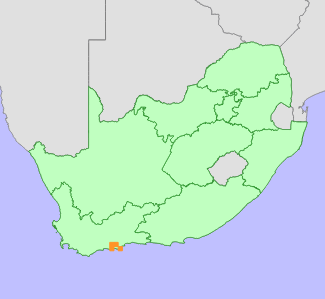|
Scientific Name | Erica bauera Andrews subsp. bauera |
Higher Classification | Dicotyledons |
Family | ERICACEAE |
Synonyms | Erica bowieana Lodd. |
National Status |
Status and Criteria | Endangered A2c; B1ab(i,ii,iii,iv,v)+2ab(i,ii,iii,iv,v); C1+2a(ii) |
Assessment Date | 2012/08/13 |
Assessor(s) | D. Raimondo, A.L. Schutte-Vlok, R.C. Turner & L. von Staden |
Justification | Erica baueri, or Albertinia Heath, is one of the most well known and widely cultivated species of Erica, but has become extremely rare in the wild. Fewer than 500 plants at four locations remain after this range-restricted subspecies' EOO has been reduced by 90% due to habitat loss and degradation due to crop cultivation, alien invasive plants, inappropriate veld management and overgrazing (current EOO 21 km²). Recent loss of habitat at the location with the largest number of remaining plants is estimated to have caused 50% population reduction within one generation (15 years) and decline is continuing. |
Distribution |
Endemism | South African endemic |
Provincial distribution | Western Cape |
Range | Riversdale to Albertinia. |
Habitat and Ecology |
Major system | Terrestrial |
Major habitats | Canca Limestone Fynbos, Albertinia Sand Fynbos, Hartenbos Dune Thicket |
Description | Sandy flats in Albertinia Sand Fynbos. |
Threats |
| About 35% of this subspecies' habitat is already transformed, predominantly for crop cultivation. However, a much larger proportion is likely to be severely degraded due to veld management practices to promote the growth of thatching reed, and which are particularly detrimental to tall reseeders, but is difficult to quantify using spatial land cover mapping. In addition, remaining fragments of natural vegetation are infested with alien invasive plants and often heavily overgrazed due to overstocking. This subspecies is also likely to have declined due to overpicking in the past - this is a particularly attractive species that was wild-harvested for the flower industry in the past. |
Population |
Erica baueri is a very restricted species, which originally probably extended as one large population over an area of about 200 km². Through habitat loss and transformation, the EOO has however been reduced by 90% to only 21 km². Many historical records indicate that this subspecies was formerly very common, but it is currently known from only four locations. At two of these, less than 10 plants survive, while at a third location, about 500 plants were counted in 2006. About 60% of the remaining sand fynbos on this farm has subsequently been ploughed, which is estimated to have resulted in a 50% reduction in the population size.
|
Population trend | Decreasing |
Assessment History |
Taxon assessed |
Status and Criteria |
Citation/Red List version | | Erica baueri Andrews subsp. baueri | CR B2ab(i,ii,iii,iv,v) | 2012.1 | | Erica baueri Andrews subsp. baueri | CR B2ab(i,ii,iii,iv,v) | Raimondo et al. (2009) | | Erica baueri Andrews subsp. baueri | Vulnerable | Hilton-Taylor (1996) | |
Bibliography |
Baker, H.A. and Oliver, E.G.H. 1967. Ericas in southern Africa. Purnell, Cape Town & Johannesburg.
Hilton-Taylor, C. 1996. Red data list of southern African plants. Strelitzia 4. South African National Botanical Institute, Pretoria.
Oliver, E.G.H. and Oliver, I.M. 2002. The genus Erica (Ericaceae) in southern Africa: taxonomic notes 1. Bothalia 32(1):37-61.
Raimondo, D., von Staden, L., Foden, W., Victor, J.E., Helme, N.A., Turner, R.C., Kamundi, D.A. and Manyama, P.A. 2009. Red List of South African Plants. Strelitzia 25. South African National Biodiversity Institute, Pretoria.
Schumann, D., Kirsten, G. and Oliver, E.G.H. 1992. Ericas of South Africa. Fernwood Press, Cape Town.
|
Citation |
| Raimondo, D., Schutte-Vlok, A.L., Turner, R.C. & von Staden, L. 2012. Erica bauera Andrews subsp. bauera. National Assessment: Red List of South African Plants version 2024.1. Accessed on 2025/10/24 |
 Comment on this assessment
Comment on this assessment

